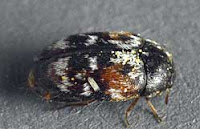Which "Bugs" Are More Common In Homes?
 |
| hobo spider (drawing) |
Almost every home harbors at least a few insects, spiders and mites. Most of these critters are harmless or can be managed in simple ways that don't use insecticides or other harsh chemicals.
In the lists below I've grouped those that are common in almost every home from those that occur only occasionally under specific circumstances, and those that may "invade" homes, usually from an outside source. There are also the so called "incidentals", that fly or crawl in through an open door or window by accident. The incidentals (moths, crickets, millipedes, and so forth) can be sweep up and deposited outside, or disposed of in the trash.
For all the others use the links below to find pictures, life history and least-toxic control strategies.
Common Household Pests
 |
| varied carpet beetle |
Ants (several species) enter houses from outside but can also nest in walls and ceilings. Most can be managed with inexpensive baits but some stubborn colonies need more aggressive treatment. [more...]
Carpet beetles (see photo) are small, slow moving insects that infest stored foods and natural fabrics. [more...]
Dust mites are tiny, microscope mites that feed on the organic debris found in homes. These mites are so small that unless you are allergic to them you probably are unaware that they are even exist. [more...]
Spiders are very common in houses, most are harmless. Sticky spider traps are the best overall control for large spiders that wander inside homes like brown recluse spiders and hobo spiders (see drawing top left).
Occasional Household Pests
 |
| house centipede |
Clothes moths are small, tan moths whose larvae feed on and damage animal-based fabrics such as wool and silk. Adult moths are sometimes found fluttering inside closets [more...]
Cockroaches are world-champion scavengers and can survive on just about any scape of food we leave for them. They sometimes indicate unsanitary conditions and can be especially troublesome in apartment buildings. [more...]
Drain flies are tiny, somewhat hairy flies whose larvae infest bathroom and kitchen drains feeding on the gunk that develops in the pipes. Adult flies are found around sinks, both stages are harmless and can be managed with new drain cleaners. [more...]
Fleas (common only if pets are present) are the bane of every pet owner but can be easily controlled nowadays with topical flea treatments and insect growth regulators. [more...]
Fungus gnats are tiny, dark-colored flies whose larvae develop in potting soil feeding on roots and soil fungi. These flies can be present in large numbers in homes and are attracted to light, often aggregating at windows. [more...]
Grain mites, also called mold mites, feed on fungi and mold growing on damp surfaces. They frequently infest stored grains, especially if the grain is damp and moldy. The presence of mold mites in homes often indicates high humidity, dampness, or even a water leak. [more...]
House centipedes are scary-looking (see photo) but generally harmless inhabitants of damp basements. Sticky spider traps are effective if control is necessary. [more ...]
Pantry (meal) moths are small moths whose larvae infest stored foods like cereals and dry pet food. Adult moths are found fluttering in areas where food is stored. Use pheromone traps to detect and pinpoint infestations. [more...]
Psocids (booklice) are small, light-colored insects that are associated with damp, moldy areas such as old, musty books (hence the name "booklice"). They are not related to true lice and do not bite.
Stored product beetles include numerous species of beetles whose larvae infest stored foods, grains and sometimes natural fabrics. [more...]
Silverfish are small, silvery, fish-shaped insects that inhabit damp areas of homes. Silverfish can damage starchy/papery materials like books and papers but they are otherwise harmless. [more...]
Pests That Seem To "Invade" Homes
 |
| bird mite |
Bird mites are also called nest mites or rodent mites. These mites infest the nests of birds and rodents where they feed on the blood of birds or rodents. These mites bite people as well when they are forced from their host animal's nest. They do not, however, infest homes for the long-term. [more...]
Clover mites are related to spider mites but are distinguished by a pair of very long front legs that can resemble antennae.
Cluster flies look like house flies and can enter houses in the fall when they seek shelter for the winter months.
Lady beetles (ladybugs) like cluster flies and boxelder bugs sometimes enter homes in the fall looking for a place to spend the winter.
Root weevils are beetles whose larvae feed on the roots of landscape plants. The adult beetles sometimes enter homes but cause no damage.
Springtails (Collembola) are tiny, primitive insects that live in soil. They are characterized by an ability to jump when disturbed. They can sometimes enter homes in large numbers but cause no damage. [more...]
** bed bugs, black flies, fleas, lice, biting midges, mosquitoes, ticks, carpenter ants, carpenter bees, wood wasps, powderpost beetles, termites, bees, fire ants, wasps, nuisance ants, pantry pests, cockroaches, carpet beetles, clothes moths, nest mites, chigger mites, scabies and mange mites, horse and deer flies, stable flies, boxelder bugs, cluster flies, house flies, fungus gnats, drain flies, lady beetles, silverfish and firebrats, vinegar flies, dust mites, venomous spiders, and delusions and phobias
----------
Comments